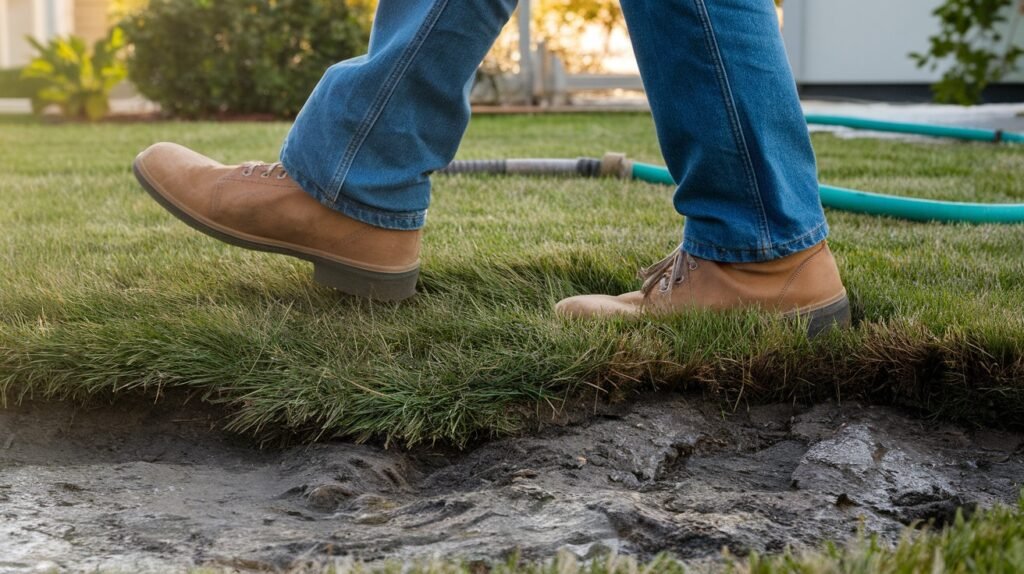Are You Stepping Into Soggy Surprises?
Nothing ruins a peaceful morning walk across your yard quite like that unsettling feeling when your foot suddenly drops into soft, spongy ground.
If your lawn sinks when walking on it, you’re not alone in this frustrating experience.
That sinking sensation isn’t just annoying; it’s your grass telling you something’s wrong beneath the surface.
Maybe it’s poor drainage turning your soil into a marshy mess, or perhaps years of foot traffic have packed everything down too tightly. Sometimes, underground surprises like decaying tree roots or pest tunnels are the culprits.
The good news? Most sinking lawn problems have straightforward solutions that won’t break your budget or require calling in expensive contractors.
Let’s walk through exactly what’s causing your yard to feel like a trampoline and how to get it solid again.
Common Reasons Why Lawns Sink When You Walk
- Soil Compaction – Heavy foot traffic, lawn equipment, or vehicles compress soil particles together, removing air pockets that normally provide structure. This creates dense, hard-packed earth that can’t support weight properly and feels soft or spongy underfoot.
- Poor Drainage or Waterlogging – Excess water from overwatering, poor grading, or blocked drainage systems saturates the soil and weakens its structural integrity. Waterlogged ground loses its ability to bear weight, creating that unstable, mushy feeling when you step on it.
- Organic Matter Breakdown – Old tree stumps, buried wood debris, or large root systems decompose underground, leaving hollow spaces or loose soil pockets. As this organic material continues to break down, it creates voids that cause the surface to sink or feel unstable.
- Underground Pests or Tunnels – Moles, voles, grubs, and other burrowing creatures create extensive tunnel networks beneath your grass that compromise soil stability. These underground highways weaken the ground’s foundation, making it feel soft or causing sudden dips when walked on.
- Poor Initial Landscaping or Grading – Improper backfill material, inadequate soil compaction during construction, or uneven grading creates weak spots in your lawn’s foundation. These construction shortcuts often reveal themselves years later as sinking areas that weren’t properly prepared from the start.
Step-by-Step Fix for Sinking Lawns
A. Aerate the Soil
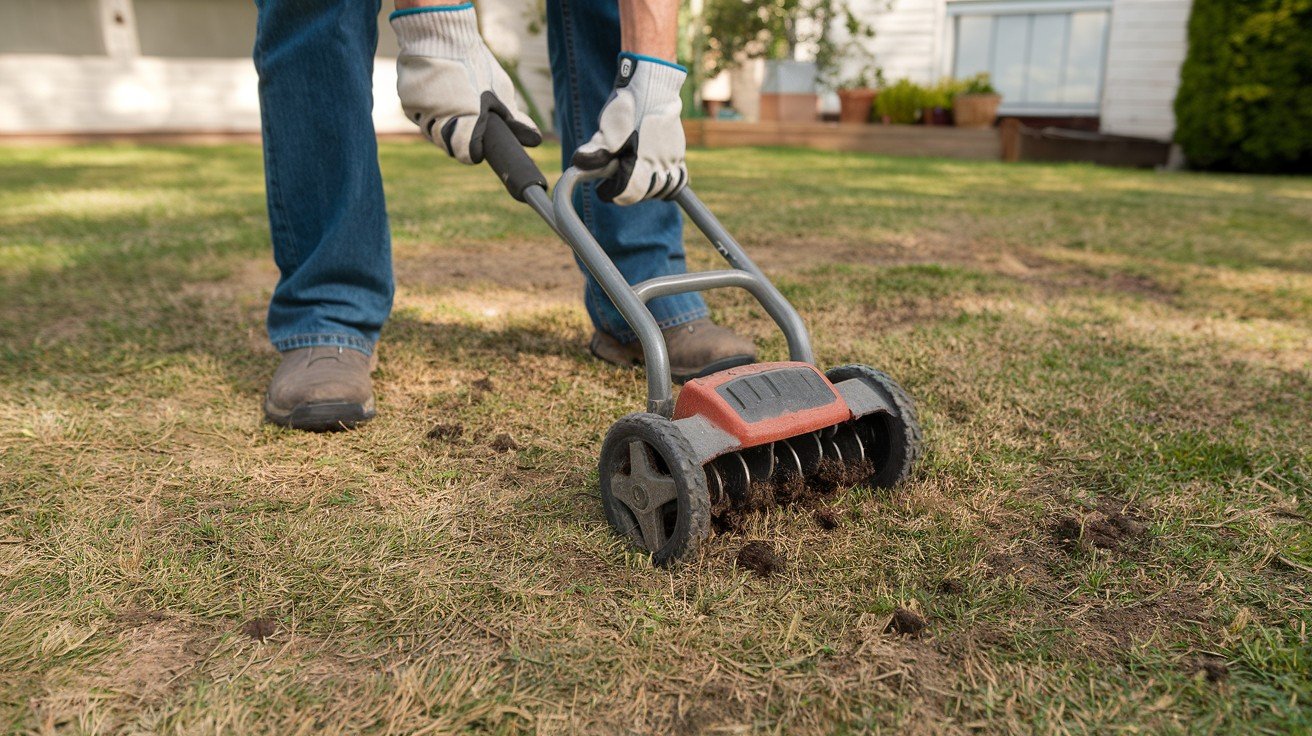
Aeration breaks up compacted soil by creating small holes that allow air, water, and nutrients to penetrate deeper. This process restores soil structure and improves drainage naturally.
Use a manual aerator for small areas or rent a machine aerator for larger lawns. Focus on the most compacted zones, making passes in different directions for thorough coverage.
B. Top-Dress and Level
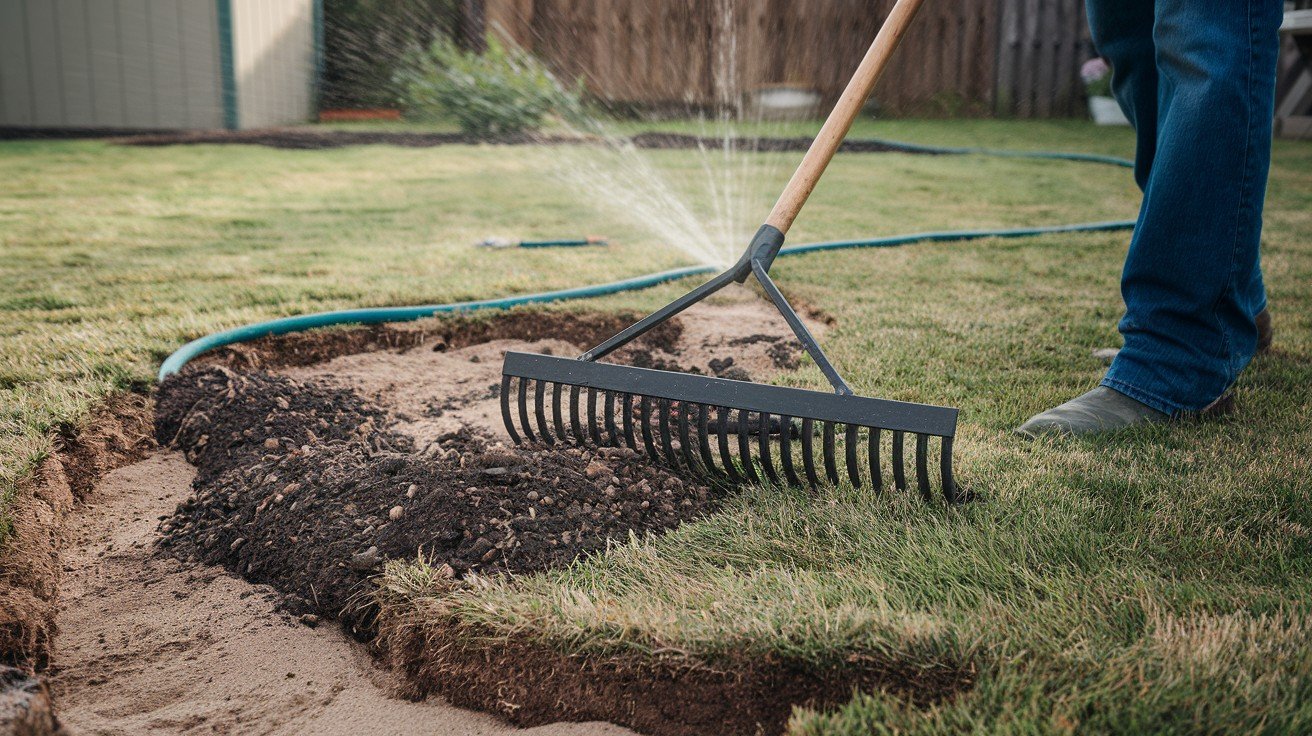
Mix equal parts quality compost, coarse sand, and topsoil to create an ideal amendment blend. Spread this mixture evenly across affected areas using a rake, filling low spots while maintaining proper grade.
Water lightly after application to help materials settle, then allow several days for natural compaction before assessing if additional layers are needed.
C. Improve Drainage (if needed)
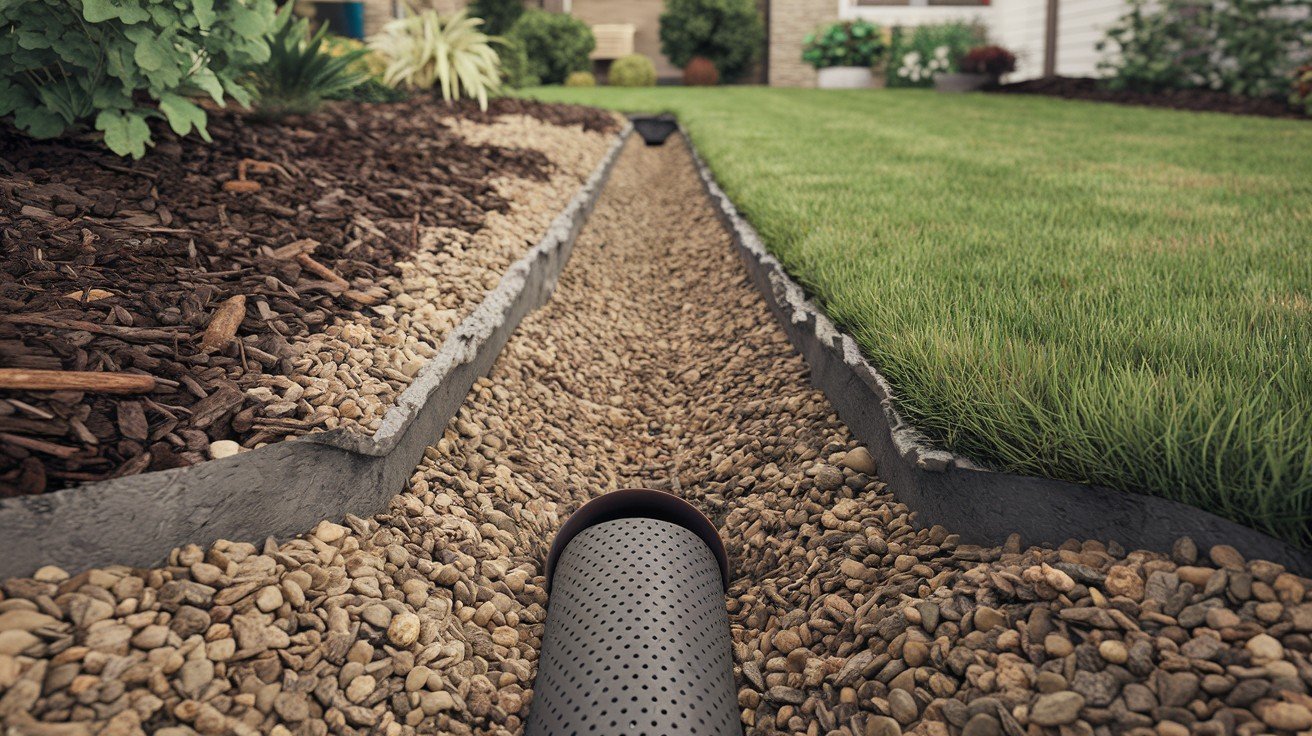
Install French drains in persistently wet areas by digging trenches filled with gravel and perforated pipe. Create dry wells for standing water collection, or adjust grading to direct water away from problem zones.
Ensure all drainage solutions redirect water to appropriate areas without creating new problems for neighbors or foundations.
D. Repair and Fill Deep Sinkholes or Depressions
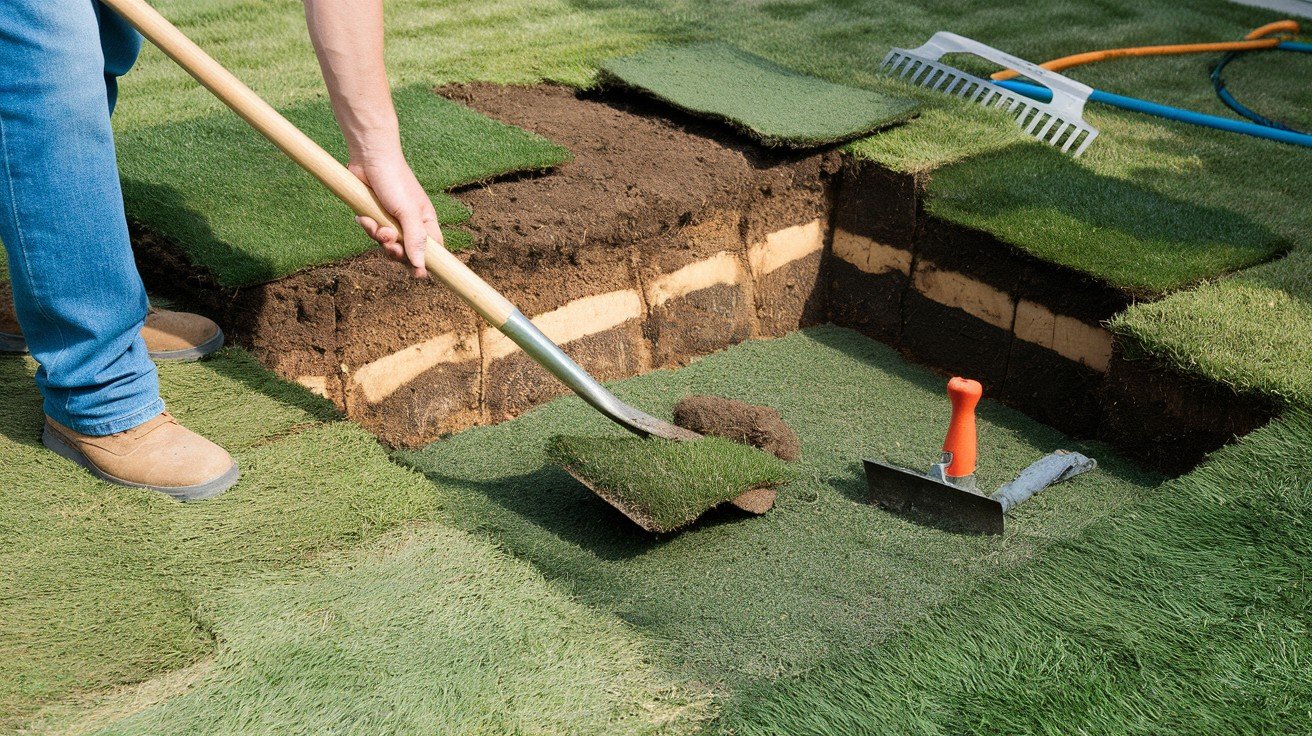
Carefully remove and set aside healthy grass sections from sunken areas. Fill holes with quality soil in 6-inch layers, compacting each layer thoroughly before adding the next.
Once filled to proper grade, replace saved sod pieces or overseed with appropriate grass type, then water consistently until established.
Prevent Future Sinking
Establish a regular aeration schedule, performing core aeration annually in spring or fall to maintain healthy soil structure and prevent compaction from rebuilding.
Avoid walking on or using heavy equipment on saturated ground, as wet soil compresses easily and loses its structural integrity.
Monitor your irrigation system carefully and adjust watering schedules to prevent overwatering, which weakens soil foundations. Maintain consistent lawn care practices, including proper mowing height, appropriate fertilization timing, and regular dethatching to keep grass roots strong and soil biology active.
These preventive measures work together to maintain stable, well-draining soil that won’t develop sinking problems over time.
When to Call a Professional?
Contact a professional when you notice signs of major structural problems like foundation settling, retaining wall movement, or widespread soil instability that affects multiple areas of your property.
Large depressions that continue expanding despite your repair efforts often indicate deeper underlying issues that require specialized equipment and expertise.
Call for help immediately if you suspect underground utility damage, extensive pest infestations, or massive root system problems that could affect nearby structures.
Professional contractors have the tools to safely investigate underground pipes, electrical lines, and septic systems without causing additional damage.
They can also handle complex drainage solutions that require permits or specialized installation techniques beyond typical homeowner capabilities.
Eco-Friendly and Budget Options
DIY Compost for Topdressing
Create your nutrient-rich compost by combining kitchen scraps like vegetable peels, coffee grounds, and eggshells with yard waste such as grass clippings, fallen leaves, and small branches.
This homemade amendment costs virtually nothing while providing excellent soil structure improvement and organic matter that helps prevent future sinking issues.
Renting Tools Instead of Buying
Save hundreds of dollars by renting core aerators, sod cutters, and compactors from local equipment rental shops for occasional lawn repairs.
Most tools needed for lawn fixes are used infrequently, making rental far more economical than purchasing equipment that will sit unused in your garage.
Water-Wise Drainage Fixes
Install natural drainage solutions like shallow swales that direct water flow, rain gardens that capture runoff, or strategic plantings of native species with deep root systems.
These eco-friendly approaches cost less than traditional drainage systems while providing habitat for local wildlife and reducing your environmental impact.
Conclusion
Fixing a sinking lawn doesn’t have to be overwhelming or expensive. By understanding the root causes, from soil compaction to poor drainage, you can choose the right repair approach for your specific situation.
Most homeowners can handle basic fixes like aeration and topdressing with simple tools and weekend effort.
Remember that prevention is always easier than a cure. Regular maintenance, smart watering practices, and avoiding traffic on wet soil will keep your lawn stable for years to come.
Start with the simplest solutions first, and don’t hesitate to call professionals for complex issues involving utilities or major structural problems.
With patience and the right approach, you can convert that spongy, unstable ground back into a firm, healthy lawn that feels solid underfoot.
Your yard will not only look better but also provide a safe, stable surface for family activities and daily use.
Frequently Asked Questions
How often should I aerate my lawn to prevent sinking issues?
Aerate annually in spring or fall, or twice yearly for high-traffic areas with clay soil.
Can I fix small sinking spots without replacing the entire lawn?
Yes, spot-treat problem areas with aeration, topdressing, and targeted drainage improvements as needed.
What’s the most common cause of lawns that sink when walked on?
Soil compaction from foot traffic and poor drainage are the leading causes of sinking lawns.

